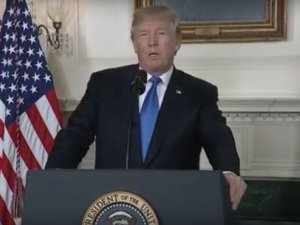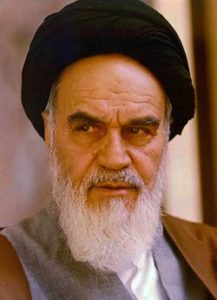Thirteen of the 14 Muslim Groups identified by the U.S. intelligence community as actively hostile to the US are Sunni, not Shia, and are not supported by Iran:
A group of U.S. intelligence veterans urges President Trump to stop his administration’s false claims about Iran being the leading state sponsor of terrorism when U.S. allies, such as Saudi Arabia, are clearly much guiltier.
MEMORANDUM FOR: The President
FROM: Veteran Intelligence Professionals for Sanity
SUBJECT: Is Iran the “World’s Leading Sponsor of Terrorism?”
EXECUTIVE SUMMARY/BACKGROUND
We are concerned by recent strident and stark public statements from key members of your Administration that paint Iran in very alarmist terms. The average American, without the benefit of history, could easily be persuaded that Iran poses an imminent threat and that there is no alternative for us but military conflict.

President Donald Trump addresses the nation about his Iran policy on Oct. 13, 2017. (Screenshot from Whitehouse.gov)
We find this uncomfortably familiar territory. Ten years ago former President George W. Bush was contemplating a war with Iran when, in November of 2007, intelligence analysts issued a formal National Intelligence Estimate (NIE) debunking the prevailing conventional wisdom; namely, that Iran was on the verge of getting a nuclear weapon. The NIE concluded that Iran had stopped working on a nuclear weapon in 2003.
Recalling this moment in his memoir, Decision Points, President Bush noted that the NIE’s “eye-popping” intelligence findings stayed his hand. He added this rhetorical question: “How could I possibly explain using the military to destroy the nuclear facilities of a country the intelligence community said had no active nuclear weapons program?”
We believe that you are facing a similar situation today. But instead of an inaccurate claim that Iran has nuclear weapons, the new canard to justify war with Iran is the claim that Iran remains the “world’s leading state sponsor of terrorism.” This is incorrect, as we explain below.
* * *
One of the recurring big bipartisan lies being pushed on the public with the enthusiastic help of a largely pliant media is that Iran is the prime sponsor of terrorism in the world today.
In the recent presentation of your administration’s National Security Strategy for 2018, the point is made that:
“Iran, the world’s leading state sponsor of terrorism, has taken advantage of instability to expand its influence through partners and proxies, weapon proliferation, and funding. . . . Iran continues to perpetuate the cycle of violence in the region, causing grievous harm to civilian populations.”
Those sentiments are echoed by several other countries of the Middle East. Saudi Arabia’s Foreign Minister, Adel al-Jubeir, for example, declared in October 2015 that: Iran “is the biggest sponsor of terrorism in the world, and it is working on destabilizing the region.”
The Saudi foreign minister conveniently declined to mention that 15 of the 19 terrorists who hijacked planes and attacked America on 11 September 2001 were Saudis, not Iranians. And, while Iran was an active promoter of terrorism two decades ago, it is no longer in the forefront of global terrorism. Ironically, that dubious distinction now goes to Iran’s accusers — first and foremost, Saudi Arabia.
The depiction of Iran as “the world’s leading state sponsor of terrorism” is not supported by the facts. While Iran is guilty of having used terrorism as a national policy tool, the Iran of 2017 is not the Iran of 1981. In the early days of the Islamic Republic, Iranian operatives routinely carried out car bombings, kidnappings and assassinations of dissidents and of American citizens. That has not been the case for many years. Despite frequent claims by U.S. officials that Iran is engaged in terrorism, we simply note that the incidents recorded annually in the U.S. Department of State’s Patterns of Global Terrorism rarely identifies a terrorist incident as an act by or on behalf of Iran.
Iran’s relationship with Hezbollah also has evolved radically. In the early years of the Islamic Republic, Hezbollah was often a proxy and sub-contractor for Iran. But during the last 20 years Hezbollah has become an entity and political force in its own right. It fought Israel to a standstill in 2006 in southern Lebanon, which was a watershed moment in establishing Hezbollah’s transformation into a conventional army. In the intervening years, Hezbollah, which is now part of the Lebanese government, also has turned away from the radical, religious driven violence that is the hallmark of the Sunni extremists, like ISIS.
Iran’s Asymmetrical Response
After Iran fell under the rule of the Ayatollah in 1979 terrorism, its role in high profile terrorist attacks, such as the taking of U.S. hostages and the bombings of the U.S. Embassy and the Marine barracks in Lebanon, fed understandable U.S. animosity towards Iran. But Iran’s actions were not driven primarily by blind hatred or radical religious views. For Iran terrorism was a way to punch back against more powerful foes, principally the United States, which was providing military and intelligence support to Iran’s neighbor and enemy, Iraq.

Portrait of the late Ruhollah Khomeini by Mohammad Sayyid
The Iranians were also pragmatic and had direct dealings with Israel. During the early days of the Iranian revolution the Mullahs, despite publicly denouncing Israel, happily accepted secret military support from the Israelis. Israel was equally pragmatic. The Israeli leaders ignored the Mullahs and gave the support as a means of helping counter the threat posed by Iraqi President Saddam Hussein. A classic case of the enemy of my enemy is my friend.
The public image of Iran as a hotbed of fanatical terrorists has been usurped since the August 1998 bombings of the U.S. Embassies in east Africa by Al Qaeda and other radical Sunni entities. The U.S. Government’s own list of terrorist attacks since 2001 shows a dramatic drop in the violence carried out by Iran and an accompanying surge in horrific acts by radical Sunni Muslims who are not aligned with Iran. The latest edition of the Global Terrorism Index, a project of the U.S. Department of Homeland Security, shows that four groups accounted for 74 percent of all fatalities from terrorism in 2015 — Boko Haram, Al-Qaeda, the Taliban and ISIS.
Thirteen of the 14 Muslim Groups identified by the U.S. intelligence community as actively hostile to the US are Sunni, not Shia, and are not supported by Iran:
READ THE REST OF THE ARTICLE HERE
No comments:
Post a Comment